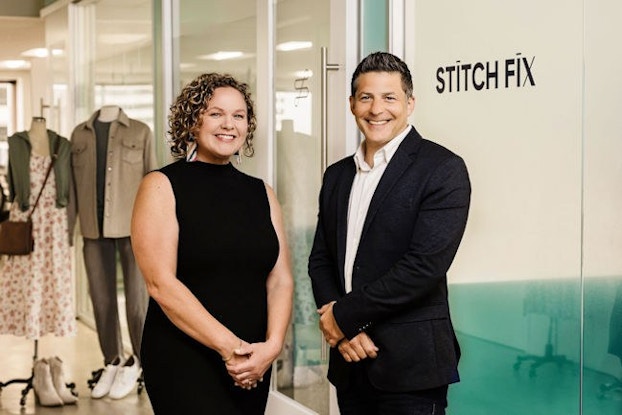
Why it matters:
- Stitch Fix, as part of a turnaround plan, has refreshed the brand and created more flexible shopping options for customers.
- The online apparel subscription service is emphasizing the human side of its fashion recommendations by spotlighting profiles of the 1,600 stylists it’s leveraging to drive “deeper relationships with our clients,” Vice President Noah Zamansky told CO—.
- The company sees a growth opportunity in the $369.9 billion U.S. apparel, footwear, and accessories market, which is estimated to grow to $422.7 billion by 2028.
At a time when apparel brands are leaning into artificial intelligence (AI) shopping assistants, personalized online clothing subscription service Stitch Fix believes it has an edge.
Stitch Fix has been perfecting its clothing recommendation algorithms for 14 years and has roughly 1,600 human stylists who combine the power of AI with a personal touch.
Now, as part of the company’s turnaround strategy, it is leaning into the human side of that business model, with a renewed focus on its stylists.
“One of the biggest trends is putting humans in the loop with AI,” Stitch Fix’s Vice President of Product, Tech and Design, Client Experience, Noah Zamansky told CO—.
“We find that the human touch helps us drive deeper relationships with our clients, and building those client relationships drives higher loyalty,” he said.
“To me it’s a fairly intuitive separation of who does what best,” Sarah Funderburk, Stitch Fix’s Vice President of Styling and Client Support, told CO—.
“What AI is really great at is narrowing things down and getting the information we need so the human can step in and make all of the connections that are nuanced to the client,” she said.
AI tools can take the client’s preferences and requests and sift through hundreds of thousands of clothing items to select a smaller set, which the stylist can use to create a coordinated outfit, Funderburk said.
One of the biggest trends is putting humans in the loop with AI.Noah Zamansky, Vice President of Product, Tech and Design, Client Experience, Stitch Fix
“By automating that initial process, stylists get to focus on what they do best — understanding the client, fulfilling their nuanced style requests, and building those relationships,” she said.
Zamansky and Funderburk spoke with CO— about how Stitch Fix is using AI and human stylists to improve the customer experience and drive sales.
The company is fostering a more personal relationship between clients and stylists by providing more information about stylists while also offering customers more flexibility in how they shop.
Stitch Fix's turnaround plan is showing results
Stitch Fix is two years into a turnaround plan headed by Matt Baer, a former digital executive at Macy’s and Walmart, who became the Stitch Fix CEO in June 2023.
Prior to Baer’s arrival, the company had been struggling with declining sales and a dramatic drop in its active customer base. In its most recent quarterly earnings results, released in June, Stitch Fix reported that it had returned to revenue growth on a year-over-year basis and that it was stemming the decline in customers with the lowest quarterly drop in three years.
Stitch Fix was launched in 2011 by Katrina Lake, who used customer surveys and data science to pick clothes for clients.
The company launched a men’s business in 2016 and went public in 2017.
Stitch Fix customers start the fashion curation process by taking an online survey about their clothing preferences, sizes, and budgets. Then they receive a “fix” — an assortment of coordinated clothing items designed to reflect their preferences. They are only billed for items they decide to keep.
Seeing opportunity in a $422 billion market by pivoting to meet ‘our clients’ evolving expectations’
In its latest earnings report, Stitch Fix said it believes it has an opportunity to gain sales in the growing U.S. apparel market. Stitch Fix cited data from market research firm Circana that estimates the U.S. apparel, footwear, and accessories market will expand to $422.7 billion by 2028, up from $369.9 billion last year.
When Stitch Fix embarked on its turnaround strategy, it started by “thinking about how we reimagine the experience and make it more dynamic and flexible and modern so we can keep up with our clients’ evolving expectations,” Zamansky said.
The company, he said, had a 14-year track record of being able “to build client relationships and help people feel confident about what they were wearing.” But, he said, “the market and clients’ expectations had shifted, and we weren’t evolving quickly enough.”
“With the emergence of new trends and social media, we were fighting for clients’ attention spans,” he said.
The steps the company took included revamping the onboarding process used to get to know a new customer’s tastes and sizes.
“We wanted to reimagine that to help clients get started with us in a more intuitive, dynamic way,” Zamansky said.

‘A big step forward’ in AI and stylists working together
Stitch Fix also shined a spotlight on the role of its human stylists by creating profiles of each stylist that tell clients about the person who selected their clothes.
“That’s been a big step forward in the evolution of showcasing what’s great about Stitch Fix — the technology and our stylists together,” Zamansky said.
The profiles contain a photo of the stylist, his or her name, and information such as their hobbies or how many “fixes” they have styled with the company, Funderburk said.
Customers have responded to the profiles with comments like, “So glad to finally meet you,” or “I love golf too,” Funderburk said. “It’s a fairly simple thing, but it’s really upleveled the level of connection our clients are feeling with their stylist,” she said.
The company has seen a big increase in the number of clients asking to be paired with the same stylist again since adding the profiles, Zamansky said.
The fashion makeover: More brands and private-label lines along with new and more flexible ‘Fix' options
Stitch Fix also has expanded its inventory with additional brands and private label offerings.
The company has given customers more purchase options, too, enabling clients to build a Fix around a Freestyle item (Freestyle allows clients to purchase a single item rather than a complete “fix” of related items); themed fixes tied to specific events or occasions; and larger fixes, with up to eight items in a shipment instead of the usual five.
Customers want a fix for ‘broken shopping’
Stitch Fix has seen positive results this year from those changes. CEO Matt Baer reported in June that the company’s average order value was up 10%, and the retailer recorded two consecutive quarters of year-over-year new client growth, with those clients typically spending more.
“This demonstrates that we are successfully acquiring higher-value clients for whom our service resonates,” Baer told investors.
Stitch Fix is offering a solution to consumers who want a better shopping experience, and the new initiatives are helping the company connect with those shoppers, Zamansky said.
“Shopping for clothes today is not a good experience,” he said. “It’s really broken. For clients it’s overwhelming — whether it’s a messy store with poor service or the endless scrolling online, they’re looking for more, and they want a better way to shop.”
The retailer wants to offer an antidote, with “a personalized, efficient experience that helps clients find the styles that they love without the hassle,” he said.
Stitch Fix “is positioned to knock the ball out of the park with the infusion and evolution of AI into their platform,” Michael Prendergast, Managing Director of the Consumer and Retail Group at Alvarez & Marsal, a global consulting firm, told CO—.
“It’s already based on algorithms that determine what you want to wear based on your style preferences,” Prendergast said. “Advanced AI and technology could catapult this.”
“This seems like a moment where the future is already here for them,” he said. “Now it’s up to them to determine if they can capitalize on it or not.”
CO— aims to bring you inspiration from leading respected experts. However, before making any business decision, you should consult a professional who can advise you based on your individual situation.

Interested in a small business membership?
Find out how the U.S. Chamber of Commerce can help your company grow and thrive in today's rapidly-evolving business environment. Connect with our team to learn how a small business membership can benefit your bottom line and help you achieve your goals.







